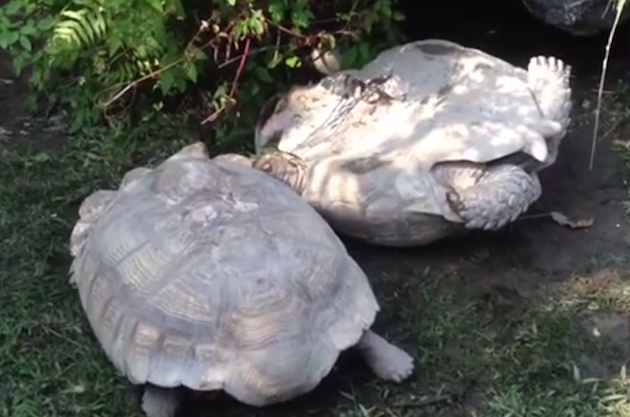'Helpful Tortoise' in Viral Video Probably Not All That Helpful

Sometimes knowing things about the natural world is a real downer. Take, for example, a recently popular video of two tortoises in the Taipei Zoo, reposted on sites from The Dodo to Huffington Post to ABC News.
In the video, we see an African sulcata tortoise on its back, feet waving somewhat helplessly in the air. Another tortoise gets underneath its companion, flipping it back onto its feet, and then the pair amble off-camera at a respectable pace for tortoises.
The clip has gone more or less viral, with one news outlet after another posting accompanying text about the "helpful" tortoise righting its "friend." But it may be that the tortoise flipping its companion back right-side up was precisely as helpful as that schoolyard bully who eventually gives you back your hat.
(Not that I'm still scarred or anything.)
Here's the video:
Sulcata tortoises (Centrochelys sulcata), also called African spurred tortoises, are sometimes mistaken for California desert tortoises, and there's some reason for that. They're both native to deserts -- sulcatas hail from the southern fringes of the Sahara -- and they have roughly similar behavior. Most importantly for our purposes here, both male sulcatas and male desert torts from California will battle over territory and access to mates by ramming each other, trying to determine who's the biggest and baddest tortoise.
And the loser often finds himself wrong-side up.
But as tortoise biologist Tim Shields told me, it almost never ends there. Shields, who's been working with and observing tortoises in North America's deserts for more than three decades, points out that each battle between tortoises is just one interaction in a complex web of social relationships among tortoises with adjoining territories. Once the contest is decided, says Shields, it's in the victor's interest for the loser to survive. Otherwise, some bigger, badder tortoise might just slide in to the loser's vacated territory.
Or there may be some other reason for the victorious tortoises' habit of righting their upended foes. But right them they do. "In more than thirty years," says Shields, "I have never seen a battle end up with a tortoise on its back with the winner walking away.I'm not saying it never happens, but I've never seen it."
There's also the chance, as biologist David Steen told National Geographic, that the upside down tortoise in the Taipei Zoo is a female, whom the other tort -- presumably male -- was courting a bit too aggressively.
Whether the tortoises are males engaging in ritual warfare or a male and a female pair in which the male is attempting to mate by force, the real explanation for the Taipei Zoo tortoises' behavior is hardly as cheerful as has been suggested in most of the commentary on the video. "There's no interpretation that I can think of where the tortoises are friends and trying to save each other," Steen told National Geographic. "I know I'm kind of being a buzzkill here."
I'm not sure I agree with the buzzkill part, though. Sure, the truth is not nearly as superficially uplifting as it would be if the smaller tortoise was turned right-side up out of pure kindness and affection from the larger tortoise. But the truth is a glimpse into the long-term behavior of an ancient tribe with more than 200 million years of history behind it.
And that's a bit of a buzz all by itself.


